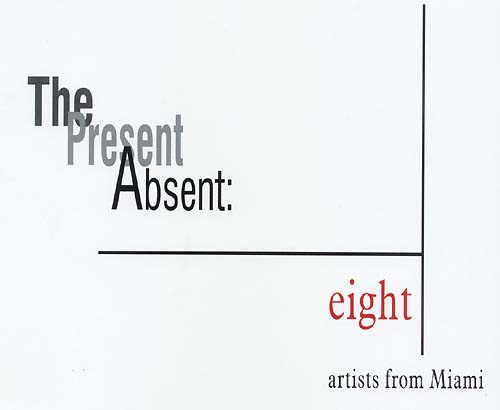

![]()
September 30 through December 15, 1999
Miami International Airport
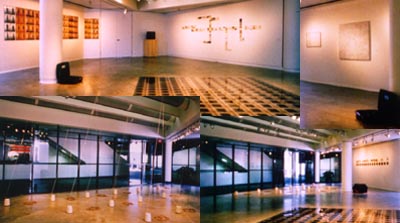 It was a great pleasure to see this exhibit,
The Present Absent: Eight Artists from Miami, continue in Miami at
mia Gallery as the Opening Event of Tigertail's 5th Annual FLA/BRA Festival. The exchange began in Rio de Janeiro at
Paço Imperial in July, 1999. Beginning at Paço, an 18th century building, palace of the King when Portugal's
court moved to Rio during Napoleon's reign, it continues at mia, an international contemporary gallery in the Miami
International Airport. The work transcends physical locations, crosses borders and gives us an opportunity to view vibrant
new work by artists of our own community.
It was a great pleasure to see this exhibit,
The Present Absent: Eight Artists from Miami, continue in Miami at
mia Gallery as the Opening Event of Tigertail's 5th Annual FLA/BRA Festival. The exchange began in Rio de Janeiro at
Paço Imperial in July, 1999. Beginning at Paço, an 18th century building, palace of the King when Portugal's
court moved to Rio during Napoleon's reign, it continues at mia, an international contemporary gallery in the Miami
International Airport. The work transcends physical locations, crosses borders and gives us an opportunity to view vibrant
new work by artists of our own community.
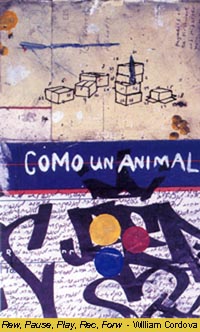
Faithful to its mission of presenting programs of an international scope reflecting the cultural resources
of Miami-Dade County, and also highlighting the resources of those destinations served by our airport, mia Gallery is proud
to begin its first full season with The Present Absent: Eight Artists from Miami. This exhibition, which made its debut this
summer in Rio de Janeiro, Brazil, features eight of the best contemporary artists living in Miami and continues the dialogue
initiated several years ago with the first artistic exchange between Brazil and Miami sponsored by Tigertail Productions.
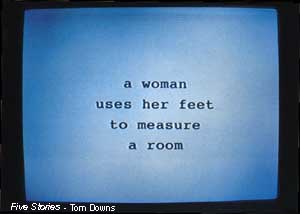 What is particularly special for us in bringing you this exhibition is its grounding in a broader cultural framework, the
FLA/BRA Festival, which includes the presentation of other artistic forms, such as dance, theatre, music and film. The
inclusion of these other art forms provides an anchor for the visual presentation and imbues it with greater meaning - the
exhibit connects to something beyond itself and provides another counterpoint to the issues which surface as these two cultures
converse with one another. Implicit in this dialogue are themes that highlight our nomadic existence and perhaps even challenge
our romantic notions about nomadism - questions about who we are, and where we are, where we belong, and who and what the art
represents. In a sense, the exhibit itself is a nomadic object especially in its current presentation in the airport setting.
What is particularly special for us in bringing you this exhibition is its grounding in a broader cultural framework, the
FLA/BRA Festival, which includes the presentation of other artistic forms, such as dance, theatre, music and film. The
inclusion of these other art forms provides an anchor for the visual presentation and imbues it with greater meaning - the
exhibit connects to something beyond itself and provides another counterpoint to the issues which surface as these two cultures
converse with one another. Implicit in this dialogue are themes that highlight our nomadic existence and perhaps even challenge
our romantic notions about nomadism - questions about who we are, and where we are, where we belong, and who and what the art
represents. In a sense, the exhibit itself is a nomadic object especially in its current presentation in the airport setting.
We are very pleased to participate in a project that challenges our preconceptions about Brazil, about Florida, about
ourselves.
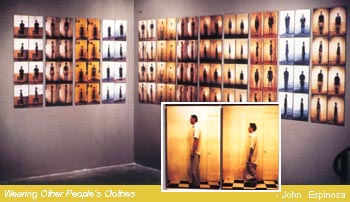
It seems quite appropriate that the works of these eight Miami-based artists were shown in Miami's newest "alternative"
space, mia Gallery located in The temple of hyper-mobility and international exchange of Miami International Airport.
The exhibition is the latest segment of an artistic exchange endeavor organized by Tigertall Productions that has transported
artists and their works between Brazil and Miami for the past three years. A key ingredient in the selection of this group of
works was the artists' ability to literally carry the work underarm to Rio de Janeiro last July for an exhibition at Paço
Imperial, a former Portuguese colonial palace now dedicated to contemporary art, As Lauro Cavalcanti, the curator of this
exhibition and the director of Paço Imperial, visited artists' studios in Miami last fall, he held in the back of his mind
two non-negotiable curatorial restrictions: a very limited budget for shipping and the specter of Brazil's formidable customs
bureaucracy. The work had to be easily transported as part of the owner's luggage and flexible enough to potentially morph in
response to an exhibition space the artist had not yet seen - Paço Imperial's cavernous lower galleries, once ground level
storerooms for the palace above.
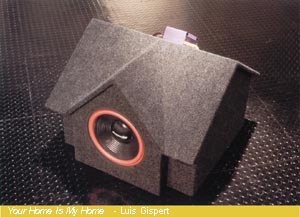 For this second exhibition, these limitations were beneficial.
Some works had to be slightly altered to fit the smaller space
of mia Gallery. Like contemporary artists around the world, these artists are accustomed to working within space restrictions
when necessary. The ability to do so can give an artist an early career edge. As the diversity of forms and materials of art
have expanded, such constraints have been embraced as part of the creative process -
For this second exhibition, these limitations were beneficial.
Some works had to be slightly altered to fit the smaller space
of mia Gallery. Like contemporary artists around the world, these artists are accustomed to working within space restrictions
when necessary. The ability to do so can give an artist an early career edge. As the diversity of forms and materials of art
have expanded, such constraints have been embraced as part of the creative process -
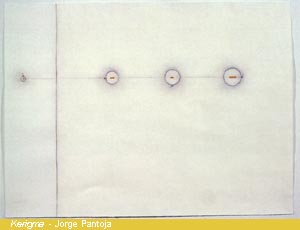 a conceptual strategy that defines the
question being asked and instructs the form the work ultimately takes. Particularly true in the case of site specific
installations, artistic ideas often thrive under slight duress as they find alternative ways to flourish.
a conceptual strategy that defines the
question being asked and instructs the form the work ultimately takes. Particularly true in the case of site specific
installations, artistic ideas often thrive under slight duress as they find alternative ways to flourish.
These eight artists - William Cordova, Tom Downs, John Espinosa, Luis Gispert, Jorge Pantoja, Karen A. Rifas, Ruben Torres-Llorca,
and Eugenia Vargas - were chosen as a sampling of some of the most stimulating artists working in Miami. Their work reflects the
quality and concerns of art being made today in cities as far flung as Tokyo, Johannesburg, London and Rio, and utilizes a
diverse range of materials: spools of thread and oak leaves, video, traditional photography and drawing, carved wood, text,
sound, altered found objects, 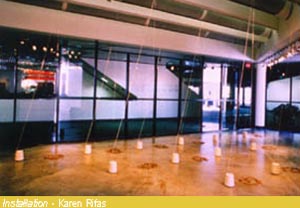 as well as painting with such
substances as liquid paper and china markers. The ideas these works
revolve around hint to a sense that humans are in a rather precarious state - things are changing so rapidly and our feeling is
now less than secure. No doubt this sense of imbalance can be partly attributed to the recent history of those artists or their
families who have immigrated to Miami from other countries, but, also, rapid change initiated by new technology and easy access
to global information has shaken the norms by which we govern our personal relationships and undermined our sense of personal
and cultural identity. It seems that all is flux and all is transient.
as well as painting with such
substances as liquid paper and china markers. The ideas these works
revolve around hint to a sense that humans are in a rather precarious state - things are changing so rapidly and our feeling is
now less than secure. No doubt this sense of imbalance can be partly attributed to the recent history of those artists or their
families who have immigrated to Miami from other countries, but, also, rapid change initiated by new technology and easy access
to global information has shaken the norms by which we govern our personal relationships and undermined our sense of personal
and cultural identity. It seems that all is flux and all is transient.
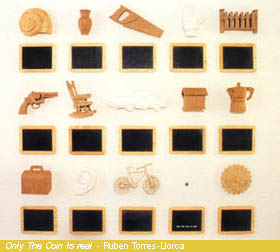 It is not surprising that the work in The Present Absent: Eight Artists from Miami does not resonate a particularly Miami
personality. Nor did the exhibition, The Present Absent:, Five Artists from Rio, which I curated for presentation in Miami
in the fall of 1998, look particularly "Brazilian. " When I traveled to Rio to select the artists and their works, I was struck
by the similarity of the concerns and forms being probed in Rio to these currently addressed by artists throughout the world, My
choice of title, The Present Absent, which has been adopted for this new exhibition, alludes to the constancy of change,
its destabilizing impact on the individual psyche, the relativity of meaning and cultural identity, and to the ephemeral memory
and the corporeal body. As in the works of the artists from Brazil, the weft in this exhibition urge one to question what one
sees, what one thinks one knows and to remain flexible.
It is not surprising that the work in The Present Absent: Eight Artists from Miami does not resonate a particularly Miami
personality. Nor did the exhibition, The Present Absent:, Five Artists from Rio, which I curated for presentation in Miami
in the fall of 1998, look particularly "Brazilian. " When I traveled to Rio to select the artists and their works, I was struck
by the similarity of the concerns and forms being probed in Rio to these currently addressed by artists throughout the world, My
choice of title, The Present Absent, which has been adopted for this new exhibition, alludes to the constancy of change,
its destabilizing impact on the individual psyche, the relativity of meaning and cultural identity, and to the ephemeral memory
and the corporeal body. As in the works of the artists from Brazil, the weft in this exhibition urge one to question what one
sees, what one thinks one knows and to remain flexible.
Remember that 91,000 passengers pass through MIA in a single day
